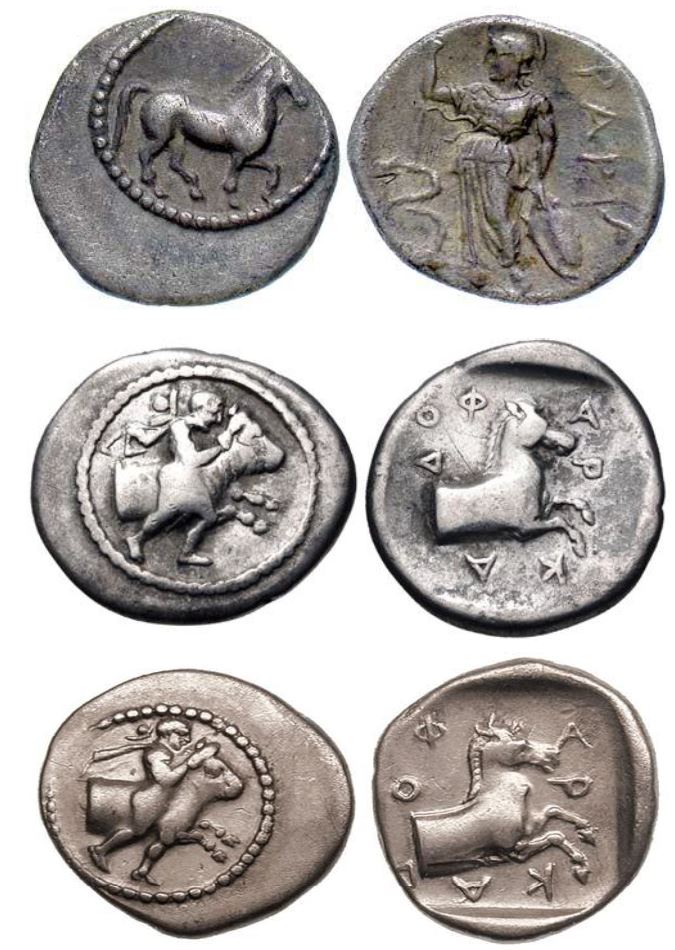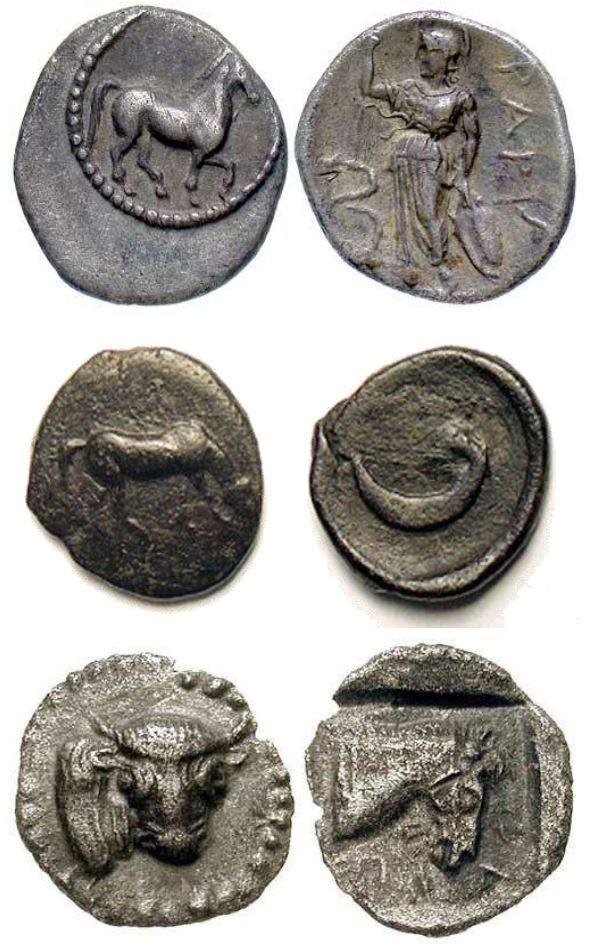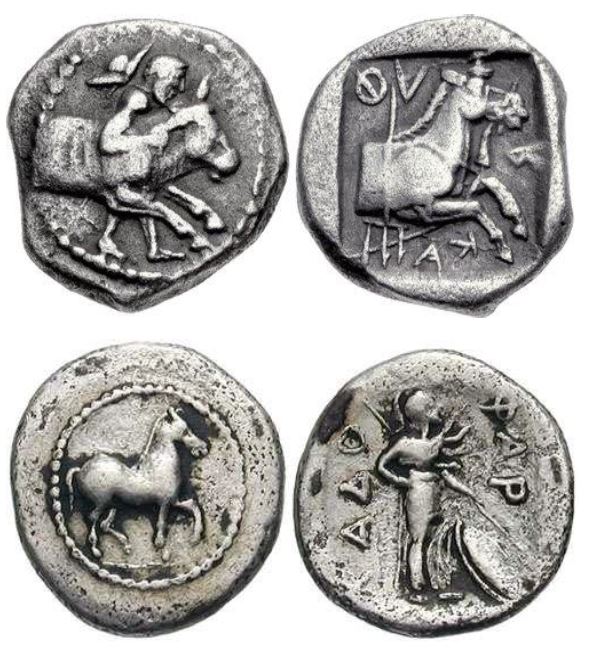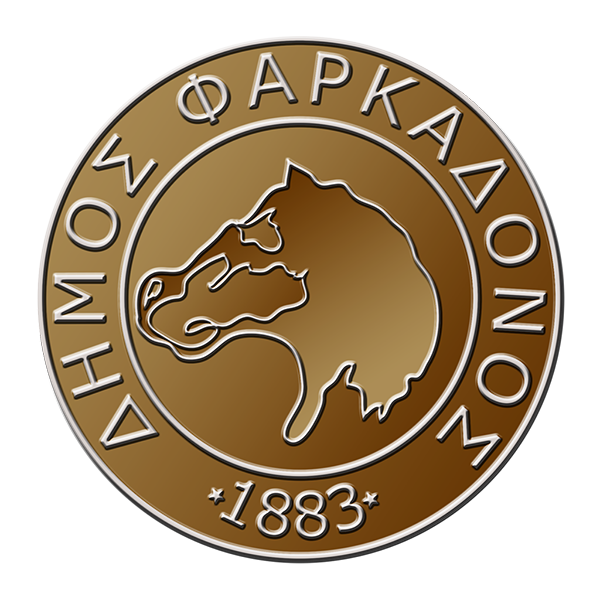The location of the city
Ancient Farkadona was the second strongest (after Trikki) city of the ancient Thessalian state of Estiaiotida. It was built near the current community of Klokotos, in the place “Vigla”, as mentioned by Strabo.
The city developed on the meridian slopes of the two hills N., NE. of the village. On the western lowest hill (altitude 205 m) was the citadel of the ancient city, while the highest (altitude 252 m) to the east was unguarded as only a section of wall existed along the ridge that connected the two hills, as ascertained from its remains and philological sources.
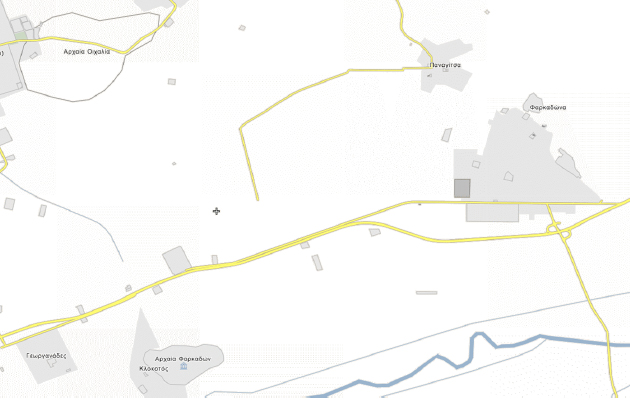
The name of the city
The word Farkadon probably came from:
a) from the name of a plant that was called Farka with the later addition of the ending – δον. This opinion was formulated by STAHLIN based on the historical evidence of Stephanos Byzantium, who refers to this plant.
b) from the verb frasso → farxai and means a barrier.
c) from its first settler or from one of its lords named Farkas.
The founding of the city
When Farkadona was founded is unknown.
Some authors and historians on their maps place it among the most ancient Estiaio cities, together with Oichalia, Phaistos, etc., but this cannot be verified. The fact is, however, that this is a very ancient city, of which we have significant evidence only at the time of its destruction (4th century BC).
The history of the city
Philip invades Thessaly. In the year 357 BC Philip II, father of M. Alexander, tried to interfere in the internal affairs of Thessaly with the ultimate goal of conquering them. He came down with the slogan “liberator” but his plan failed because he found strong resistance from Farkadona, Trikki and Phayto, as many times as he tried to invade Thessaly from the region of Farkadona. So he was forced to change tactics.
With intelligent diplomacy he imposed his influence on Thessaly.
1. he was proclaimed general of the public of Thessaly,
2. re-established the old organization of the four tribal states,
3. repair fortifications,
4. he placed Macedonian garrisons in strategically important cities and thus imposed himself on the Thessalian cities with strategies and not with weapons.
Philip takes Farkadona
After the victory at Krokio Pedio, after first capturing Larissa, Philip with his army proceeded to subjugate Farkadona. At the beginning of the siege he met strong resistance from the defenders of the city. But then he used ladders on the unwalled side of the higher of the two hills and his mercenaries managed to climb the citadel. Finally he managed to capture the entire city, destroyed the walls, the public buildings and exiled its inhabitants.
After the conquest of Thessaly by the Macedonians, Farkadona declined into an infamous settlement:
✓ ceased to exist as an independent city
✓ to mint its own coins
✓ while almost all of her estates went to Pelinna who was Philip’s protégé
Although the Farkadonians capitulated and began to hope that things might change with the new conqueror. But they never made an alliance with the Macedonians of their own free will. Their minds were always on the revolution that was attempted many times but all drowned in blood.
It is characteristic that the men of the army of Farkadona who took part in the Campaign of Alexander the Great were the only ones along with the Amphissians, Trikkaians and Heraklions who were not allowed in the year 323 BC. together with the other soldiers to return to their homelands. A major role in this decision of Alexander’s was played – apart from the political pressure of Pelinna – by his being informed by the Tetrarch of Estiaiotida about the revolutionary dispositions of the Farkadonians who would be encouraged more with the veterans because their power would increase significantly and the their opinion of possible revolutionary action.
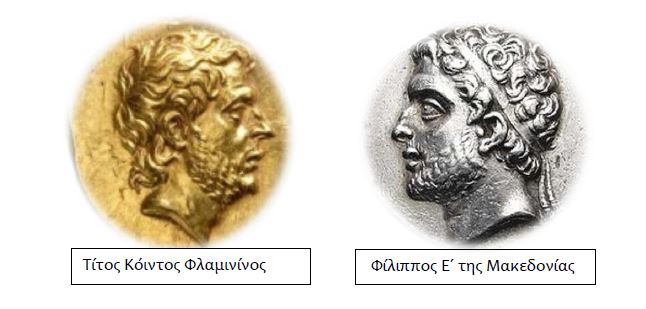
The end of Macedonian rule
The ban on returning and the soldiers staying in the depths of Asia Minor gave rise to a new revolutionary effort by the Farkadonians against the Macedonian Antipater. Antipater, however, managed to break up the forces of the Thessalian cities through intrigue.
The Gallic invasion
280 BC The Farkadonians, like other cities, are subject to the raiding fury of the Gauls who indulge in incredible depredations.
New effort against the Macedonian hegemony
229 e.g. the Thessalian cities of Eastern Estiaiotida led by Farkadona – possibly also Phaito – revolt and declare their independence against the Macedonian hegemony. In 229 BC, after the death of King Demetrius II of Macedonia, several cities of western Thessaly, among them Farkadona, tried to escape Macedonian control and come under Aetolian protection. But the very next year the important victory of Antigonus Doson against the Aetolians seems to have allowed the Macedonians to regain their influence in most if not all of these cities.
They may have submitted again to the Macedonians, but they continued their lives not as vassals, but as their allies, as can be deduced from the conference of 221 BC. in Corinth where the Thessalians were included as autonomous members. Macedonian rule in Thessaly lasted until 197 BC. when the King of Macedonia, Philip V, was defeated at Kynos Kephales by the Roman ruler Titus Coido Flamininus.
In the next six years, various alliances and military efforts were made by Philip V to recapture the cities of Estiaiotida, but without ultimately succeeding. The only thing he succeeded in was the removal of all the provisions for the maintenance of the inhabitants, the burning of the houses and the general destruction of the Thessalian cities, hoping that in this way he would force Flamininus to return to Epirus, since he would find nothing to supply his soldiers.
Roman and Byzantine times
This destructive invention of Philip V was destined to include the cities of Farkadona, Faytos and Facion, which were given over to the flames and turned into ruins. The plan of the Macedonian ruler may have resulted in some delay due to the winter, but Flamininus (who had taken his measures because he had foreseen the action of Philip V and took care of his supply from Epirus, which reached Thessaly via the Agrafas ), continued his advance in the Spring, conquering all the cities that offered resistance, two of which were Farkadona and Faytos.
NOTE: In 191 BC Pelinna also fell to the Romans and since then full Roman rule was imposed on Thessaly, as well as on Macedonia itself three years later.
The new conquerors continued the same policy as the Macedonians, that of “divide and rule” thus breaking the unity of the Thessalian cities and annihilating their resistances. The name “Farkadona” is mentioned until the early Byzantine era. There is no information that the city after its repeated disasters was repopulated by Farkadonians. Where did its inhabitants settle? And this is unknown. It is not certain if the Farkadonians settled in the current settlement of Klokotos, which is built near the ancient Farkadona.
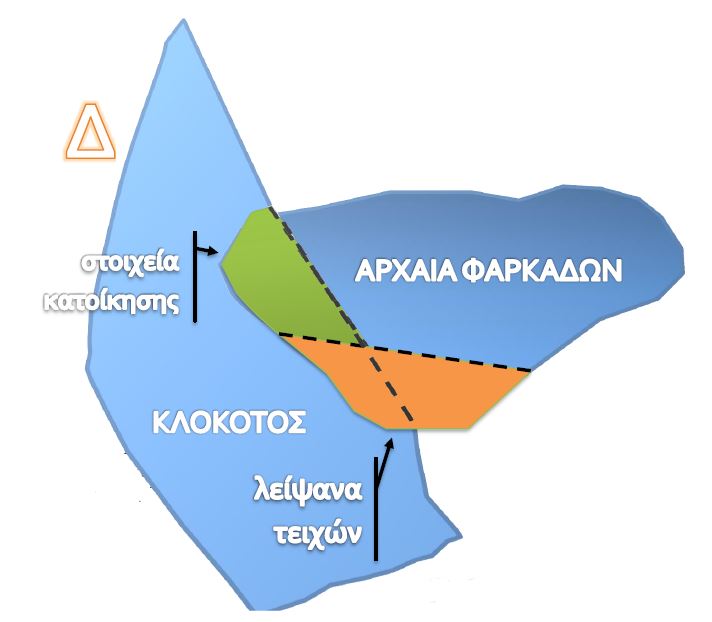

Archaeological findings
It is unknown when ancient Farkadona was founded. The oldest evidence of habitation in Klokotos can be found to the west of the boundaries of the ancient city and the village, where an ancient cemetery of the Proto-Geometric and Geometric eras was found and some graves were excavated containing copper buckles as offerings.
More, are the parts of the fortification from the Byzantine years. In the Byzantine church of the Holy Apostles Peter and Paul of Klokotos, within the boundaries of the ancient city, the construction of several architectural members can be seen in second use.
The church of the Holy Apostles Peter and Paul is located within the boundaries of the old settlement of the community of Klokotos Trikala. The hill on the edge of which the church was built preserves remains of ancient and Byzantine walls, which are considered to belong to the acropolis of ancient Farkadona.
Economic life – Coins
From the monetary circulation of Farkadona, its original power is established. The coins that are saved correspond to three periods:
– in the time of Alexander the Great,
– at the time of the Macedonian dynasty,
– from 344 to 197, and in the period from the time of Flamininus to the time of Diocletian.
Specimens of coins
Among the most noteworthy is a very well-preserved rare silver obelisk (around 462 – 460 BC, where the neck and head of a bull are depicted in front and a wheat ear above. On the reverse surface, a horse’s head to the right, behind the letters PHAR, below a trident, all within concave square.
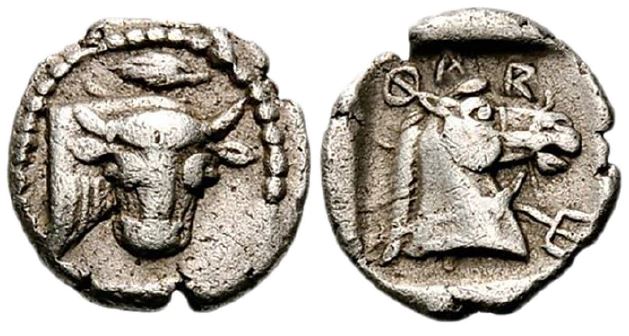
Silver hemidrachm, circa 460 – 400 BC. , where Thessalus is represented in stride, with a petasus hanging around his neck, with both hands around – in front of – the head of a bull moving right. On reverse FA-RKA, head and torso of horse right, trident, all within concave square.
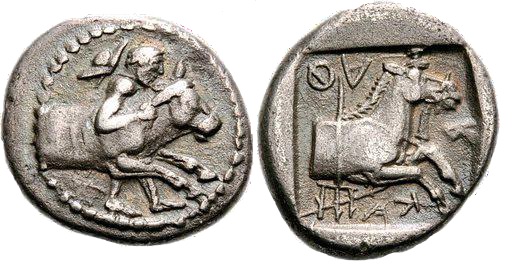
In the same era, an excellent silver hemidrachm depicts Thessalus striding right, with a cloak and petasus hanging behind his neck, with both hands around his head – forepart of a bull moving right. On reverse surface inscription FARCADONI, head and torso of horse to right, all within shallow concave square.
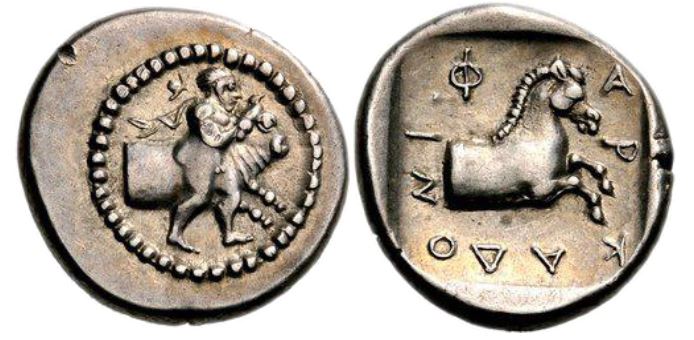
Around 440 – 400 BC dated a very rare silver half-drachm showing bull’s head right on obverse, ram standing left, inscription FARK, all within concave square.
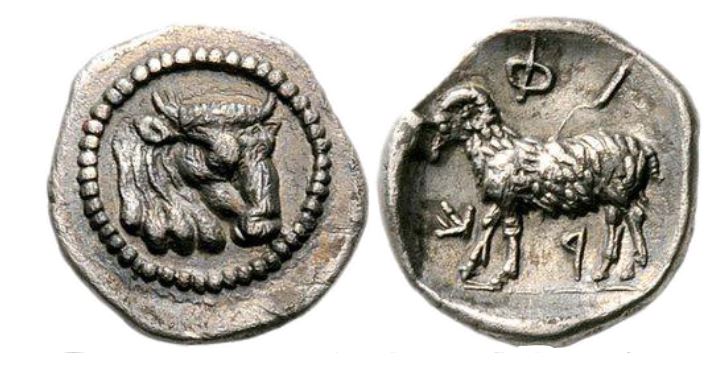
In a very interesting, rather unpublished, silver cut from the beginning of the 4th century BC, a horse is depicted to the right. On the reverse, in the concave square, the hero Herakles is depicted standing on the right naked, holding the bow with his left hand and the lioness wrapped on his arm, while with his right hand he holds the club resting on the ground, inscription FARK.
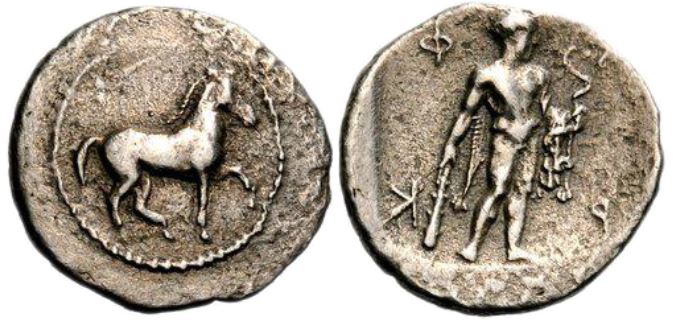
On the obverse of a rare copper coin of the first half of the 4th century BC. a horse is depicted to the right on a six-pointed star, inscription FARK-DONOS, perhaps indicating worship of Ennodia (Ancient Greek deity, the female form of Hermes).
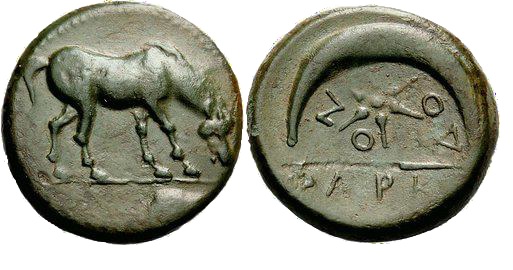
From the indicative presentation of these silver and bronze coins of Farkadona and the brief historical data, it can be seen according to Mr. Chatziagelakis, that the heyday of the ancient city manifests itself in the 6th century until the middle of the 4th century. BC, while the shrinking and withering occurs with its conquest and destruction by Philip II of Macedonia. Here are some more sample coins.
